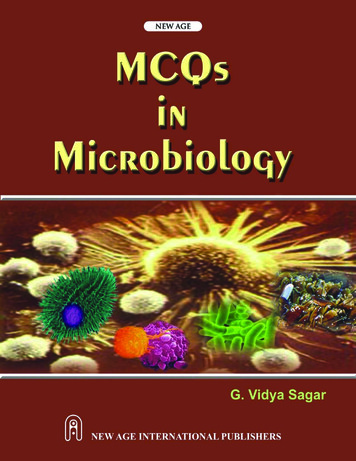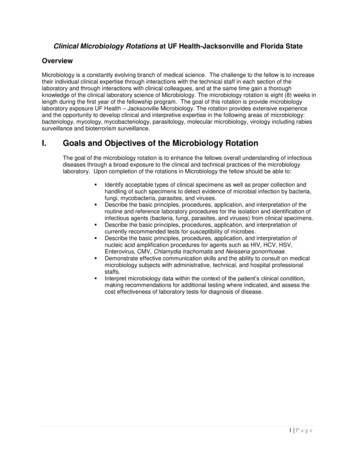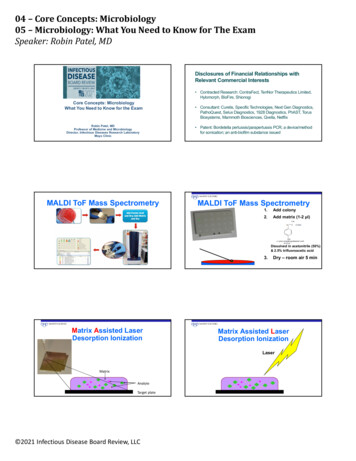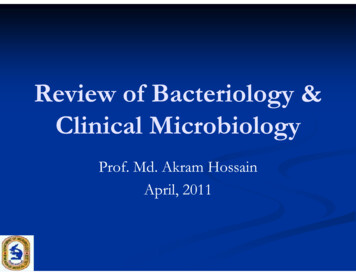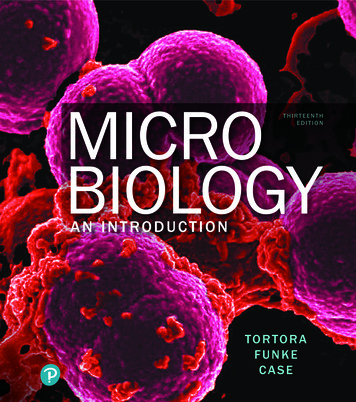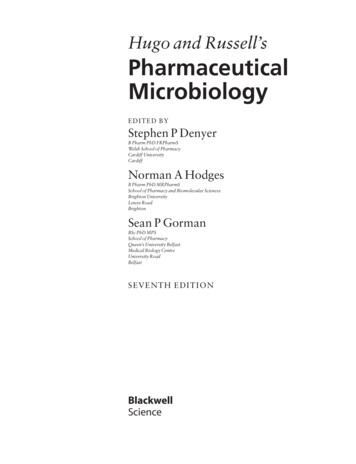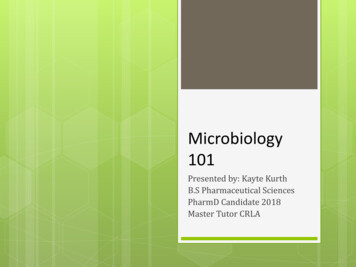
Transcription
Microbiology101Presented by: Kayte KurthB.S Pharmaceutical SciencesPharmD Candidate 2018Master Tutor CRLA
Learning Objectives Learn differences between gram positive andgram negative bacteria. Learn the differences in biology of prokaryotesand eukaryotes. Understand antimicrobial selection Understand common laboratory tests Understand MIC creep and ways to prevent it. Have fun!
Basic Microbiology
What is microbiology? According to APIC text of Infections Control andEpidemiology: “the field of microbiology includes the study ofbacteria, fungi (molds and yeasts), protozoa, virusesand algae.” As Infection Preventionists, you are going toencounter these organisms during your career.
3 Domains of Microbiology Prokaryotes BacteriaArchaea Eukaryotes Eukarya
Prokaryotes vs. Eukaryotes Simple Usually single celledorganisms Contain no nucleus No membrane boundcell structures ComplexSingle or multi-celledHave a nucleusContain a nuclearenvelopeContain cell membranebound structures likemitochondria, golgiapparatus,etc.
ience/biology place/biocoach/cells/identify3.html
Prokaryotes: Bacteria Very small, single-celled organism Contain DNA in the form of a bacterialchromosome, which is circular May contain plasmids, which are not necessaryfor bacteria but can be helpful for survival Plasmids can carry genes for antibioticresistance, toxin production, etc. Bacteria can exchange plasmids to each otherand incorporate into their chromosome
Prokaryotes: Bacteria Complex cell wall structure Bacteria contain peptidoglycan in their cell wall Can have flagella, a long appendage formovement Can have fimbriae or pili which help withattachment Variety of cell shapes and arrangements
Prokaryotes: Bacteria pbHZlcg/
Prokaryotes: Bacteria Gram positiveHave a thick layer ofpeptidoglycanGenerally susceptible topenicillins andcephalosporinsExamples:Staphylococcus st.com/pin/393572454908490948/
8/ngoo8tdfmqo4tyh0vksu37vqroxnvs
Prokaryotes: Bacteria Gram Negative Have small layer ofpeptidoglycan Contain additionallayer called outermembrane Example: Escherichiacoli, /393572454908490948/
Prokaryotes: Bacteria May form another layercalled a glycocalyx, whichoffers additionalprotection to cell. Helps avoid immune bubKhan/bacterial-morphology-i
Prokaryotes: Bacteria Bacteria replicate by binary fission, which isdividing one cell into two cells Newly formed cells are called daughter cells Generally it is very fast E.coli can replicate very 15-20 minutesMycobacterium Tuberculosis replicates every 1224 hours
Prokaryotes: Bacteria Bacteria are very good at mutations Typically the daughter cells are exact copies ofthe original but mutations during replication(least common) or gene transfer (mostcommon) from other bacteria changes thegenome. TransformationConjugationTransduction
second-part-of-lesson-bacterial.html
generalized-transduction.html
Prokaryotes: Bacteria Atypical Bacteria Mycoplasma Lack cell wall, only have outer plasma membraneResistant to antibiotics that attack the cell wallOften require special lab testing Chlamydiae Bacteria that is obligate intracellular parasitesOnly grow inside a host Rickettsiae Also obligate intracellular parasites
Prokaryotes: Archaea Live in extreme environments Hot springs, salt lakes, Dead Sea Do not contain peptidoglycan
Eukaryotes Humans are Eukaryotes Microbes AlgaeFungi Yeasts and moldsProtozoa or Protists
Eukaryotes- Fungi Contain citin in cell walls Most people obtain fungal infections byaccident
Eukaryotes- Fungi Yeasts Single-celled organisms, reproduce by budding Examples: Candida species & Crytococcusneoformans Molds Consist of long, branching filaments called hyphae Asexual or spore reproduction Opportunistic infections Examples: Aspergillus species
Viruses Non-living organisms, not cells, not a prokaryote oreukaryoteAlso considered intracellular parasite Grow within living cells and are dependent on hostsmetabolic machinery to replicateContain DNA or RNA, in a single or double strandedformationComplex reproduction cycle that involves:Attachment, Penetration, Replication, Maturation,and Release
Viral plication/
Viruses Viruses can be detected in a variety of ways: Electron microscopy, enzyme linked immunosobentassay (ELISA), latex agglutination, DNA probes, PCR,etc.Antibody detection methods, since they cause animmune response.Difficult to cultureTesting IgG can help determine if a person has beenexposed to a virus Ex. Varicella (chicken pox)
Clinical Microbiology
Primary Goal “identify the presence of pathogenic organismsin tissues, body fluids, excretions or secretionsand to identify those pathogens species levelbased on morphological and biochemicalproperties”(APIC text of Infections Control andEpidemiology)
How do we find bacteria in patients? First, prepare a slide of the sampleobservation Wet mount, heat fixed, etc.for Second, try and make a pure culture of thebacteria in question. Typically done with the streak-plate methodWhy a pure culture? It’s the only way to get reliable identification
Other Ways to Identify Bacteria Gram Stain- Primary Test Where Gram Positive and Gram Negativeterms come from. Stepwise process of different stains whichare: crystal violet, iodine, and safranin Gram Positive bacteria stay purple or bluefrom the crystal violet/iodine complexbecause it stays in the peptidoglycan Gram Negative bacteria have the outermembrane and the stain gets washed awaywith alcohol rinse, but keeps the pinksafranin color
dure.html
Other Ways to Identify Bacteria Acid-FastStain (Mycobacterium) Serotyping Bacteriophage typing Electrophoresis Plasmid analysis PCR Many others
Antimicrobial Susceptibility Definition of Susceptibility: “state or character of being susceptible” Susceptibility helps determine whichmedication will help the patient the most tofight the infection
Antimicrobial Susceptibility- Testing Disk DiffusionBacteria is plated on aplateDisk coated inantibiotics are placedon the discThe clear zone ofinhibition is measuredCLSI guidelinessusceptible,intermediate, andresistant 134218898/lab-test-2-flash-cards/
Antimicrobial Susceptibility-Testing Broth Dilution Used to determined the least amount of antibioticnecessary to inhibit the growth of the organism or theminimal inhibitory concentration (MIC)Uses replication inoculation of the standardizedsuspension of bacteria in broth into a series of microwell containing antibiotics in different concentrationsThe first well with no growth is the MICPic?
http://www.ijmm.org/article.asp?issn 0255-0857;year 2015;volume 33;issue 2;spage 205;epage 214;aulast Kokkayil
Antimicrobial Susceptibility-Testing E-test Combines both disk diffusion with ability toquantify the resistance provided by broth dilutionOften used with level of resistance is clinicallyimportant Example: Streptococcus pneumoniaepenicillins/cephalosporinswith
https://commons.wikimedia.org/wiki/File:Etest Vancomycin S icro-lab-test/deck/6011931
Antimicrobial Susceptibility-Testing Synergy Testing-used to determine the inhibitoryability of combination of antibiotics D-test with inducible clindamycin resistanceβ-lactamase Test- rapidly detects the enzyme βlactamase that can be produced by bacteria H. flu, Staph spp., Pseudomonas t
Antibiotic Resistance Mechanisms Inactivation of antibiotic β-lactamase producing bacteriaLow permeability of the bacteria to the antibioticPumping antibiotics out of the cell after they haveenteredLow binding affinity of antibiotics to the bacteria
MIC creep MIC is growing, meaning its more difficult forthe antibiotics to kill the bacteria or we needmore antibiotic to kill the bacteria This is a problem!! Can lead to treatment failures Causes antibiotics to be less effective and moreprone for adverse drug reactions with higherconcentrations Example. Vancomycin resistant MRSA
Ways to Help Decrease Resistance Use narrow spectrum antibiotics if susceptible Create and Follow practice guidelines Don’t give antibiotics for viral infections Be an advocate to patients, friends, family to tellthem to finish course of antibiotics therapy ,EVEN if they feel better Vaccinations Treat infection not colonization orcontamination
Antibiogram Stewardship Antibiogram Chart or table that summarizes in percent howsusceptible an organism was to an antibioticUsed to help determine which antibiotic to use ina known organism infectionsHelps find patterns of resistanceTypically done in an institution and/or compliedin a region or state
http://www.sirirajmedj.com/content.php?content id 2552
Example: SD
Final Thoughts Laboratories assist in the identification of anoutbreak by confirming the organism anddetecting unusual organisms and antimicrobialsusceptibility patterns Clinical Microbiology plays an important role inthe practice of infection prevention.
References Association for Professionals in Infection Control andEpidemiology, Text of Infection Control and EpidemiologyChapter 24, p2-17Nester EW, Anderson DG, Roberts CE, and Nester MT.Microbiology, A Human Perspective. 7th Edition. New York:McGraw Hill; 2012.
According to APIC text of Infections Control and Epidemiology: “the field of microbiology includes the study of bacteria, fungi (molds and yeasts), protozoa, viruses and algae.” As Infection Preventionists, you a


